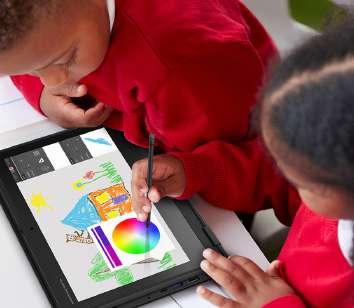Sustainable IT in education – issues, trends & attitudes among decision makers


1 Executive Summary
Market research carried out on behalf of Acer has examined the current status of IT sustainability in today’s Education sector based on the responses from 100 IT UK decision-makers from across universities and multi-academy trusts.
Despite the UK government’s Net Zero commitments and the Department for Education’s vision to be “the world-leading education sector in sustainability and climate change by 2030” only 38% of the responding organisations had so far committed to Net Zero as a target.
DEVICE 'CHURN'
Universities and multi-academy trusts include an estimated 2.2m end user computing (EUC) devices of which over 626,000 are being replaced each year, with an average replacement cycle of 3.5 years.
ENVIRONMENTAL IMPACT
Calculations by independent IT sustainability consultancy Px 3 determine the environmental impact of the use of EUC devices by these organisations to be in excess of 11,000 tons of CO2e per annum, equivalent to driving over 40 million car miles and requiring a forest of more than 13,000 acres of mature trees to remove the pollution from the atmosphere.
CLIMATE ACTION
In terms of delivering climate action only 53% of organisations surveyed have an action plan for IT with targets to address carbon reduction.
CIRCULAR ECONOMY
Only 19% stated that they had any formal policy on circular economy relating to IT and 26% reported that end of life devices are sent to their local authority for waste disposal – an estimated 120,000 units.
ENERGY SAVINGS
Px3 benchmarked Acer’s Chromebook Spin 311 and estimated that a switch to this as a low-energy alternative would reduce Scope 2 emissions (from energy use) by nearly 70% per annum when compared to a typical Windows device estate.
89% reported favouring energy-efficient devices, yet just 47% indicated they would find power consumption and Life Cycle Assessment data useful
2 Background & Key Issues
SUSTAINABILITY
Since the Industrial Revolution, human polluting activity has caused 1.0°C of global warming and an increase to 1.5°C is expected between 2030 and 2052 if emissions continue to increase at the current rate [1]. Scientists calculate that reaching and sustaining “net zero” global CO2 emissions from human activity by mid-century will halt global warming, but current strategies such as vehicle electrification and renewable energy will not be sufficient to bridge the emissions gap forecast for 2030 [2]
Scientists and governments agree that all aspects of human activity causing pollution must be examined and low-carbon alternatives researched and adopted during the next decade, with the UN Environmental Programme suggesting a combination of existing technology and innovation is required [1].
Given the criteria, end user computing EUC devices are prime candidates for change as they generate 1% of global GHG annual emissions - caused by manufacturing 460 million devices annually and the energy consumed by 4.2bn active users [3].
Current research indicates that the annual EUC device carbon footprint is 556,000,000 tCO2e of GHG emissions, equivalent to 1.4bn fossil fuel car miles and requiring a forest the size of Argentina to remove the pollution from the atmosphere [4]
Overall 10.4% of all non-domestic electricity is attributed to the use of IT solutions [5] making it the third largest consumer behind lighting (14.5%) and cooling and ventilation (13.4%) [5].
In the UK alone EUC devices are responsible for 34% of IT related pollution and up to 80% is caused by their
daily use. This “use phase” is creating 3m tonnes of CO2e, equivalent to 650,000 cars driving on UK roads annually [6].
There are signs that the IT industry is beginning to respond to environmental concerns. In 2021 Acer, one of the world’s leading device manufacturers, announced that it had joined RE 100, a global initiative bringing together the world's most influential businesses committed to 100% renewable electricity, pledging to achieve this by 2035. The Acer Group, including its global operations and subsidiaries, has already achieved its 2020 target of reducing carbon emissions by 60% worldwide.
The commitment extends beyond energy use into manufacturing and packaging. In 2020 all Acer note books switched to recycled paper for packaging, saving 8,750 kg of paper pulp and 20 million plastic bags. In addition Acer has recycled and remanufactured over 50 metric tonnes of batteries.
Acer has also launched a range of notebooks focused on sustainability, using post-consumer recycled (PCR) plastic throughout the device’s chassis and keyboard caps. The eco-friendly packaging features a shipping
box made from 80-85% recycled paper pulp, paper sleeves replacing plastic bags for adapter protection and 100% industrial recycled plastic used for the lap top bag and sheet between the keyboard and screen.
All shipping box graphics are printed with soy ink and the notebook chassis itself is not painted, reducing the environmental impact. To extend the useful life of the device and support “right to repair” initiatives the notebook features easily-accessible, standardised screws for a simpler disassembly process.
As part of their wider sustainability strategy Acer commissioned independent specialists Px3 to carry out benchmarking of devices to accurately quantify their use phase energy consumption. This data, available in technical reports and white-papers, provides customers with accurate information for CSR / ESG reporting as well as playing an important role in carbon reduction plans and “Net Zero” initiatives.
THIS UNDERLYING RESEARCH
The Market Research was commissioned by Acer and carried out by Px3 to assess the current state of IT sustainability strategy, operational practice and procurement in UK universities and multi-academy trusts by analysing the feedback from 100 decision makers in the sector.
This 'use phase' is creating 3m tonnes of CO2e, equivalent to 650,000 cars driving on UK roads annually.
Legislation and Compliance Factors
Any consideration of sustainable IT in the UK education sector needs to be set in the context of the policy paper “Sustainability and climate change: a strategy for the education and children’s services systems” [7] published 21 April 2022. This policy document supports the delivery of the government’s 25 Year Environment Plan and Net Zero Strategy and includes the action plan for the sector to meet legislative requirements.
The document specifically references a number of major UK and international goals, policies and legislative acts, including:
l the United Nations’ 17 Sustainable Development Goals and UNESCO’s ‘Education for Sustainable Development (ESD) for 2030’ which set out the key role of education in the successful achievement of the goals
l the Paris Agreement and Glasgow Climate Pact, which are important steps towards keeping the goal of 1.5 degrees Celsius alive
l Action for Climate Empowerment (ACE) which includes taking action to empower society to engage in education and training
l the United Nations Convention on the Rights of a Child (UNCRC) which ensures the needs and views of children are taken into account in the development of climate change policies
l the UK Climate Change Act (2008) and National Adaptation Programme (NAP), which include action for education in adapting to climate change and require progress reporting on GHG emissions and against priority risks
l the UK government legislation to meet net zero by 2050
l the latest UK Carbon Budget which legislated to reduce emissions 50% by 2032 and 75% by 2035, compared to 1990 levels
The introduction to the policy paper states “The DfE has an important role to play in all aspects of sustainability. But the area in which we have the most work to do is reducing our environmental foot print, particularly in the drive to achieve net zero” and further states its vision is for the UK to be “the world-leading education sector in sustainability and climate change by 2030”.
By 2023 all bids for capital funding for further education and higher education will need to consider environmental impact, carbon reduction and adaptation measures, and align with the government’s targets and objectives. The DfE committed to share best practice and advice to help education settings in deciding where to invest money to reduce carbon emissions, improve sustainability and resilience.
In addition the UK government’s updated ‘Greening ICT’ policy for 2020-2025 [8] requires EUC device procurement and subsequent operation to meet what are described as ‘hard targets’. These include a requirement for all future purchases to be accompanied by a scientific target capable of supporting the Government plan for net zero by 2050. In effect this could be as simple as selecting EUC devices proven to be energy efficient when operated in the workplace, leading to a reduction in GHG emissions.
As such guidance and legislation already exists to encourage organisations to make changes to reduce operational GHG emissions. Recent research, however, suggests that resistance factors, such as a lack of awareness, mean that over one third of organisations simply fail to react [5]. The strategy, planning and progress is examined in the subsequent sections.


4 Current Green Strategies and Commitments in Education
Overall, 79% of respondents stated that they had an IT strategy that included “Green IT”, 13% had strategies that didn’t include any mention of it and 8% either had no strategy or didn’t know.
While the 79% positive response seems initially encouraging, one third of those who responded saying their strategy included Green IT also noted that they had no targets associated with the commitment. As a result, the research indicates that only just over half (53%) of those surveyed reported that they have an actionable Green IT strategy in line with the DfE policy document and latest Greening ICT policy.
The data indicated notable geographic differences, with only around 25% of respondents in the East Midlands and North East having an actionable plan, compared with over 65% in Greater London, the South East and Yorkshire and Humberside.
The survey also examined the importance of reducing carbon footprint to the decision maker, their organisation and the respondents view on its importance to their students.
Overall, decision makers ranked sustainability highly as a concern across all three areas, but was considered to be most important to the organisation at 83%, followed by the decision makers at 79% and the students at 76%. The importance ratings given by female respondents were on average 10% higher than their male counter parts.
Not surprisingly the regional variations for the importance of carbon reduction to the organisation were very similar to those for actionable strategy, with the lowest ratings coming from the East Midlands, North East and North West. Ratings for organisational concern on average were higher for universities at 90% positive versus multi-academy trusts at 82%. Ratings for individual concerns were broadly similar across both groups, while university students ranked slightly higher at 80% versus multi-academy trust students at 76%.
Overall, the percentage responding that reducing carbon footprint was “very important” to them and their organisation was 42.5%, with “somewhat important” at 39%. While this broadly aligns with the responses on Green IT strategy it does indicate a requirement to improve the coverage and quality of the strategies action plans in order to deliver results in line with both individuals’ concerns and public policy.
In order to establish what might be being considered as an action plan, the survey also looked at the changes which the decision makers felt would be most effective in lowering their carbon footprint.
Possibly due to recent media coverage on the topic the most effective measure was considered to be switching off devices when they were not in use at 44%, followed by recycling more devices and reducing e-waste at 42% and 33% respectively. Reducing the daily consumption of energy by EUC devices and reducing printing were both considered important by 31% of respondents.
Dropping below the 25% rating for effectiveness were buying devices with recycled materials and extending the lifespan of devices, both at 24%, and moving services to the public cloud at 22%.
Only 1%, however, felt that there were no effective changes to be made.
5 Examining the Issue of Device “Churn”
Every organisation needs to replace equipment that is outdated, underperforming or poses some sort of risk, for example an IT security risk through lack of support or updates. For many organisations, however, replacing EUC devices is carried out on a regular cycle to “keep up to date” rather than being based on any specific analysis.
In the study we found that, on average, educational establishments replaced 480 EUC devices each year, however one university put their replacement programme at 2,500 devices annually.
With a total of 1,305 multi-academy trusts and universities in the UK, that suggests a significant turnover, involving the purchase and disposal by this part of the education sector alone of somewhere around 626,400 devices every year.

While the average replacement cycle was three and a half years, 67% of respondents reported replacing their EUC devices before they were four years old. Conversely 18% of those surveyed reported keeping devices in use for five years or longer and one multi-academy trust reported a refresh cycle of 10 years.
No universities reported a device replacement cycle shorter than three (compared with 24% of multi-academy trusts who did) and twice as many universities as trusts reported cycles of 4 – 5 years.
The most common reasons for replacing devices were given as performance at 63% followed by battery life at 57%. Of significantly less concern were the appearance of the device at 11% and least of all its weight at 9%.
Picking up on the environmental concerns, overall energy consumption was a low to mid-range concern driver for replacement at 31%. Also in the mid-range but higher, highlighting the risk factors, were 46% replacement due to operating system compatibility and 38% due to expiring hardware warranties.
Screen quality at 27% and screen size at 20% also featured at the lower end of the range of key issues driving EUC replacement.
The results suggest that the majority of devices are being replaced earlier than manufacturers might expect, due to concerns about their performance, functionality and compatibility rather than due to issues relating to user experience or appearance.
67% of respondents reported replacing their EUC devices before they were four years oldHands-on educational activities with an Acer Chromebook
Exploring the Actual and Potential Use of Sustainability Data
Given that 79% of organisations have Green IT as part of their overall IT strategy and it is considered important or very important to 83% of organisations, we might expect to find clear evidence of this in action plans and areas such as device procurement.
Surprisingly only 46% or respondents indicated that they had established a carbon reduction plan, with 38% committing to Net Zero as a target.
In contrast with local government where nearly 75% of organisations have declared a climate emergency, only 21% of respondents in the research indicated their organisations had currently done so. A slightly larger number, 24% reported aligning with the United Nations Sustainability Goals (SDGs) but only 19% recognised any commitment towards the circular economy and 5% of respondents reported no alignment to sustainability targets of any kind
When asked about the information which might be helpful in selecting less than 50% indicating that any of the key metrics available would be of interest. This contrasts sharply with previous research across decision makers in all sectors where 95% of respondents indicated that such measures would be of interest.
Around 47% indicated that the most comprehensive information (Life Cycle Assessment) would be useful, along with a measure of the power consumption by devices when they were not in “active use”.
40% would be interested in schemes which provided a financial rebate or discount for devices which were “traded in”, schemes like Acer Green Rewards.
The use of recycled materials in packaging and manufacturing were only rated as being of interest by 37% and 34% of respondents, while the amount of energy used when the device was actively in use was of interest to 38%.
In terms of decision-making, 89% reported favouring energy efficient devices. The most common source of these was either to use government frameworks (42%) or to select devices with the Energy Star logo (38%). Only 9% reported making independent choices while 11% identified themselves as being unsure or having no procurement policy in this area.
Access to accurate data on energy consumption is particularly important as reducing electricity use and Scope 2 emissions is essential to contribute to estates-based abatement. Added to this are the recent energy cost rises already experienced and predicted for later in the year making anything that lowers energy consumption important to assist in the careful use of education budgets as well as climate action.
From a circular economy perspective, 45% of respondents told us that they were sending the devices for recycling and 41% reported that they were donating them to charity. Perhaps surprisingly just 30% were getting some financial return by selling the devices or extending their useful life by installing a replacement operating system. Perhaps of most concern from a sustainability perspective, 26% reported that their old devices were being sent to local authority waste disposal.
89% reported favouring energy-efficient devices, yet just 47% indicated they would find power consumption and Life Cycle Assessment data useful
7 Evaluating the Benefits of Low-Energy Devices in Education
As organisations look to comply with government policy and departmental strategy they will need to focus more closely on their carbon reduction and Net Zero strategies. Given the scale (combining the replacement numbers and retention cycle would suggest a total population of just over 2.2m EUC devices across just universities and multi-academy trusts) there is no question that education will be a significant area of focus.
This means that organisations will be under pressure to weight energy-efficiency, sustainability and circular economy much higher in the selection criteria for items such as end user computing devices.
A number of vendors, including Acer, have already begun this journey with investments in recycled materials, reduced packaging and re-usable or upgradeable components.
The ACER Spin 311 is notable, however, for setting an exceptional standard in low-energy consumption, as validated by the Px3 independent benchmarking.
This exercise scientifically measured energy consumption when the device was used extensively for ‘real-world’ productivity tasks. The tests found that the Spin 311 exhibited a category-leading energy performance consuming as little as 0.019 kWh per working day.
As such, using a Spin 311 would reduce power usage and related emissions from an average mixed environment of desktops & laptops by around 70%. Compared with a typical legacy estate of Windows
desktop PCs the energy and emissions savings are estimated at an impressive 84%.
The research indicates that an average-sized organisation across universities and multi-academy trusts has 1,680 EUC devices. The annual energy savings delivered by switching these to the Spin 311 would be significant, reducing emissions by 6,433 kgs CO2e every year of use when compared with a typical Windows estate. For an average sized-establishment in the survey., that is the equivalent to reducing travel by over 23,000 UK car miles or having an additional 8 acres of mature forest removing emissions from the atmosphere.
While significant at an organisational level, the true benefits are even more impressive when illustrated at a national level. Across the UK there are 135 universities and 1,170 multi-academy trusts, giving a total of 1,305 institutions. Based on the reported number of devices per institution this indicates a total device population of 2,192,400 units.
The most recent estimates suggest a market split of 80% Windows and 10% each to Chrome OS and Apple IOS and Px3 modelling indicates that an estate of this size and mix of devices would produce over 11,000 tonnes of CO2e annually from using the devices. This is the equivalent of over 40 million car miles and would require a mature forest of 13,337 acres to remove the pollution from the atmosphere.
Switching to low-energy devices such as the Acer 311 Spin Chromebook this could be reduced to just over 3,600 tonnes ofCO2e. The savings are equivalent to
a reduction of 27.5 million car miles or having the ‘sequestration’ benefits of an extra 9,000 acres of mature forest, roughly the size of the Isle of Man
With the Spin 311 LTE Acer has demonstrated its forward-thinking and commitment to investing in devices that balance lower-energy use with the demands for performance and battery life. In the words of Px3’s Research Director “organisations seeking to adopt sustainable IT strategies are enabled to achieve abatement goals, reduce electricity consumption and accurately substantiate success by transitioning to the Acer 311 Spin Chromebook”.
using a Spin 311 would reduce power usage and related emissions from an average mixed environment of desktops & laptops by around 70%
Conclusions
The UK government has set 2032 as the target date to reduce UK greenhouse gas (GHG) emissions by 50% and the Department for Education’s latest policy paper notes the sector has an important role to play in all aspects of sustainability, but the area in which there is most work to do is reducing its environmental footprint, particularly in the drive to achieve net zero”. Despite this the research found that only 38% of the responding organisations had so far committed to Net Zero as a target.
The responses also indicate a significant issue in the area for universities and multi-academy trusts in terms of end user computing (EUC) with an estimated 2.2m devices in use across 1,305 establishments. Of these devices over 626,000 are being replaced each year, with an average replacement cycle of 3.5 years. Estimations by independent IT sustainability consultancy Px3 put the environmental impact of the energy use of these EUC devices at 11,000 tonnes of CO2e per annum, equivalent to driving over 40 million car miles and requiring a forest of over 13,400 acres of mature trees to remove the pollution from the atmosphere.
In terms of reducing the emissions, the key findings are that while IT sustainability is recognised as an important area by the UK government, educational bodies, decision makers and students, only 53% of organisations surveyed have an action plan with targets to tackle the issue. While 89% responded that they would choose energy-efficient devices only 47% felt that detailed carbon footprint or energy consumption data would be useful in decision making.
When asked what measures would be effective in reducing carbon emissions, the most effective action
was considered to be switching off devices when not in use (44% of respondents), compared with extending the lifespan of devices (24%) or buying those with recycled materials (25%). The most common reason for replacing devices was given as poor performance at 63%, yet only 22% considered moving services to public cloud as an effective strategy.
The relatively short device refresh cycle which sees 67% of organisations reported that they replaced their EUC devices before they were four years old, suggests that organisations might benefit from exploring replacement operating systems such as Chrome OS Flex to extend device life. In the research less than 30% of respondents identified this as an approach they were adopting.
Circular economy considerations did feature in the responses, with 45% sending devices for recycling and 41% reporting that they donated devices to not for profit organisations after securely deleting any data. Only 19%, however, stated that they had any formal policy in this area and 26% reported that devices were sent to their local authority for waste disposal. If that is proportionate across the sample this would amount to nearly 120,000 devices being disposed of in this way each year.
Examining the potential benefits of selecting lowerenergy devices Px3 undertook benchmarking of the Acer Chromebook 311 to estimate the impact of a switch to Chrome OS devices. The findings indicate that selecting this device for an average sized establishment of 1,680 devices could see an energy reduction of nearly 70% and save nearly 6,500 kgs of CO2e per annum.
In conclusion the research indicates that there is a lot more that needs to be done to meet Net Zero ambitions
within the sector and to deliver on climate action. Strategic carbon-reduction plans with targets and a better understanding of options are needed, supported by improved, verifiable data regarding carbon footprint and energy-efficiency. If these are shared and used it is likely that the sector could cut energy costs and at the same time achieve a reduction of 70% in its EUC-related energy use and associated Scope 2 emissions.
only 38% have committed to Net Zero
References
[1] Intergovernmental Panel on Climate Change. (2022), ‘Climate Change'. Switzerland: IPCC [2] United Nations Environment. (2018), ‘Emissions Gap Report’. Accelerating innovation is a key component in bridging the gap: 18. New York: United Nations
[3] Sutton-Parker, J. (2022), ‘Quantifying greenhouse gas abatement delivered by alternative computer operating system displacement strategies’. 1877-0509. Procedia Computer Science. Amsterdam, the Netherlands: Science Direct, Elsevier B.V.
[4] Sutton-Parker, J. (2020), 'Can meaningful end user computing carbon footprint information drive human behavioural changes to abate greenhouse gas emissions?' Warwick, UK: University of Warwick [5] Dahlmann, F., and SuttonParker, J. (2020), ‘The Cost of Running IT is the Next Sustainability Challenge’. Page 105. Paris, France: The Council on Business and Society. [6] Sutton-Parker, J. (2020), ‘Determining end user computing device Scope 2 GHG emissions with accurate use phase energy consumption measurement’. 1877-0509. Procedia Computer Science. Amsterdam, the Netherlands: Science Direct, Elsevier B.V.
[7] Sutton-Parker, J. (2021), ‘Can meaningful measure ment of end user computing energy consumption drive human behavioural changes to abate greenhouse gas emissions?’. Warwickshire, England: The University of Warwick, Computer and Urban Science Department

[8] HM Government. (2006), ‘Climate Change and sustainable energy Act’. London: The Stationery Office Limited.
Get in touch to discuss how to make your IT environment more sustainable for your educational institution: sales.uk@acer.com

